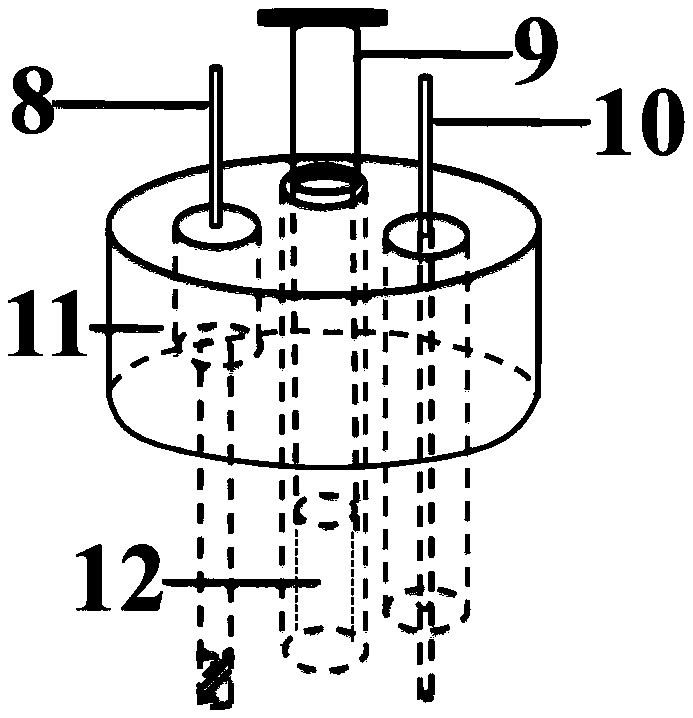Voltammetric detection of heavy metals in soil using two-step electrodeposition and stripping steps
A stripping voltammetry and detection method technology, which is applied in the detection field, can solve the problems of high detection sensitivity and anti-interference requirements, complex soil components, and difficult detection, and achieves wide detection range, high degree of portability, and easy detection. carrying effect
- Summary
- Abstract
- Description
- Claims
- Application Information
AI Technical Summary
Problems solved by technology
Method used
Image
Examples
Embodiment 1
[0037] Embodiment 1, the preparation of carbon paste electrode
[0038] ① Mix graphite powder and paraffin oil into the mortar
[0039] ② After fully grinding, put the mixture into the cavity 5 of polytetrafluoroethylene material with a diameter of 10 mm, compact and form it, and use the copper pillar as the wire at the rear end to conduct with the carbon paste.
[0040] ③ Grind the surface of the carbon paste electrode with weighing paper to obtain a smooth electrode surface.
[0041] Such as figure 2 Shown is a three-electrode sensor structure composed of graphite powder-paraffin oil carbon paste electrode, a composite electrode structure diagram composed of Ag / AgCl reference electrode 8 and platinum wire electrode, Ag / AgCl reference electrode 8, carbon paste electrode 9, platinum wire electrode The wire counter electrode 10 is combined and inserted into a composite electrode carrier 11 made of polytetrafluoroethylene.
Embodiment 2
[0042] Embodiment 2, the preparation of soil extract and blank soil extract
[0043] Pre-treatment of the collected soil. Weigh 12.5g of soil, place the soil in a constant temperature drying box, and dry the soil at a constant temperature of 100°C for 10 minutes, transfer the dried soil to a beaker, then add 500mL of acetic acid-sodium acetate buffer solution with pH5.0, and use ultrasonic The processor performs ultrasonic treatment on 500mL soil extract solution for 10 minutes, and rests for 10 minutes until the soil settles to the bottom of the bottle.
[0044] The supernatant after ultrasonic treatment was preliminarily filtered on the soil with filter paper, and then the soil extract after preliminary filtration was manually filtered through a combination of a disposable syringe and a water filter to obtain a soil extract.
[0045] Through the electrodeposition function of stripping voltammetry, the three-electrode sensor composed of graphite powder-paraffin oil carbon pa...
Embodiment 3
[0046] Embodiment 3 Modification of glassy carbon electrode and glassy carbon three-electrode sensor
[0047] The preparation process of multi-walled carbon nanotube-Nafion modified glassy carbon electrode is as follows:
[0048] ① Put 1 mg of multi-walled carbon nanotubes into 4 mL of DMF solution.
[0049] ② Use a mixer to mix the multi-walled carbon nanotube dispersion.
[0050] ③ Add 500 μL of 1% Nafion solution to the multi-walled carbon nanotube dispersion and place it in an ultrasonic processor for ultrasonic treatment.
[0051] ④ Centrifuge the mixed solution after ultrasonic treatment.
[0052] ⑤Use a pipette gun to draw 6 μL of the upper layer solution, and drop-coat it on the surface of the polished glassy carbon electrode. The glassy carbon electrode has a diameter of 3 mm.
[0053] ⑥ Place the modified electrode under an infrared drying lamp for drying.
[0054] ⑦ After drying, place the electrode in the air to cool down to room temperature naturally.
[005...
PUM
| Property | Measurement | Unit |
|---|---|---|
| diameter | aaaaa | aaaaa |
Abstract
Description
Claims
Application Information
 Login to View More
Login to View More - R&D
- Intellectual Property
- Life Sciences
- Materials
- Tech Scout
- Unparalleled Data Quality
- Higher Quality Content
- 60% Fewer Hallucinations
Browse by: Latest US Patents, China's latest patents, Technical Efficacy Thesaurus, Application Domain, Technology Topic, Popular Technical Reports.
© 2025 PatSnap. All rights reserved.Legal|Privacy policy|Modern Slavery Act Transparency Statement|Sitemap|About US| Contact US: help@patsnap.com



